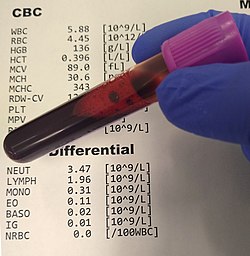Blood volume
Volume of Circulating Blood: An Overview[edit]
The volume of circulating blood refers to the total amount of blood flowing within an individual's cardiovascular system at any given moment. This volume is essential for delivering oxygen, nutrients, hormones, and other vital substances to cells throughout the body. It consists of two primary components: the plasma volume and the erythrocyte (or red blood cell) volume.

Components of Circulating Blood[edit]
Plasma Volume[edit]
Plasma is the liquid component of blood, constituting about 55% of the total blood volume in a healthy individual. It is a yellowish fluid that primarily consists of:
- Water
- Electrolytes (like sodium and potassium)
- Proteins (albumin, globulins, fibrinogen)
- Nutrients (glucose, amino acids, lipids)
- Waste products
- Gases (oxygen, carbon dioxide, nitrogen)
- Hormones
Plasma plays a crucial role in maintaining blood pressure, transporting nutrients, wastes, and hormones, and providing the medium for cellular exchange.
Erythrocyte Volume[edit]
Erythrocytes, commonly known as red blood cells (RBCs), are the most numerous cells in the blood. They comprise about 45% of the total blood volume. These biconcave disc-shaped cells contain the red pigment hemoglobin, which binds to oxygen and facilitates its transport from the lungs to body tissues.
Erythrocytes are essential for:
- Oxygen transport
- Carbon dioxide removal
- Maintaining acid-base balance in the body
Calculating Circulating Blood Volume[edit]
The average volume of circulating blood in an adult is approximately:
- 5 to 6 liters for males
- 4 to 5 liters for females
However, this can vary based on factors like body size, age, and health conditions. The formula for calculating the total circulating blood volume is:
- Total Blood Volume = Plasma Volume + Erythrocyte Volume
Importance of Circulating Blood Volume[edit]
Maintaining an appropriate circulating blood volume is vital for:
- Efficient oxygen and nutrient delivery to cells
- Removal of waste products
- Regulation of body temperature
- Maintaining adequate blood pressure
- Ensuring proper functioning of organs and tissues
A significant decrease or increase in blood volume can lead to medical conditions such as dehydration, blood loss (hemorrhage), or fluid overload.
Conclusion[edit]
Understanding the volume of circulating blood and its components is fundamental in the field of medicine, especially in treatments that involve fluid management, blood transfusions, and hemodynamic monitoring. Proper knowledge ensures that clinicians can provide optimal care for their patients, ensuring homeostasis and overall health.
Ad. Transform your life with W8MD's Budget GLP-1 injections from $75


W8MD offers a medical weight loss program to lose weight in Philadelphia. Our physician-supervised medical weight loss provides:
- Weight loss injections in NYC (generic and brand names):
- Zepbound / Mounjaro, Wegovy / Ozempic, Saxenda
- Most insurances accepted or discounted self-pay rates. We will obtain insurance prior authorizations if needed.
- Generic GLP1 weight loss injections from $75 for the starting dose.
- Also offer prescription weight loss medications including Phentermine, Qsymia, Diethylpropion, Contrave etc.
NYC weight loss doctor appointmentsNYC weight loss doctor appointments
Start your NYC weight loss journey today at our NYC medical weight loss and Philadelphia medical weight loss clinics.
- Call 718-946-5500 to lose weight in NYC or for medical weight loss in Philadelphia 215-676-2334.
- Tags:NYC medical weight loss, Philadelphia lose weight Zepbound NYC, Budget GLP1 weight loss injections, Wegovy Philadelphia, Wegovy NYC, Philadelphia medical weight loss, Brookly weight loss and Wegovy NYC
|
WikiMD's Wellness Encyclopedia |
| Let Food Be Thy Medicine Medicine Thy Food - Hippocrates |
Medical Disclaimer: WikiMD is not a substitute for professional medical advice. The information on WikiMD is provided as an information resource only, may be incorrect, outdated or misleading, and is not to be used or relied on for any diagnostic or treatment purposes. Please consult your health care provider before making any healthcare decisions or for guidance about a specific medical condition. WikiMD expressly disclaims responsibility, and shall have no liability, for any damages, loss, injury, or liability whatsoever suffered as a result of your reliance on the information contained in this site. By visiting this site you agree to the foregoing terms and conditions, which may from time to time be changed or supplemented by WikiMD. If you do not agree to the foregoing terms and conditions, you should not enter or use this site. See full disclaimer.
Credits:Most images are courtesy of Wikimedia commons, and templates, categories Wikipedia, licensed under CC BY SA or similar.
Translate this page: - East Asian
中文,
日本,
한국어,
South Asian
हिन्दी,
தமிழ்,
తెలుగు,
Urdu,
ಕನ್ನಡ,
Southeast Asian
Indonesian,
Vietnamese,
Thai,
မြန်မာဘာသာ,
বাংলা
European
español,
Deutsch,
français,
Greek,
português do Brasil,
polski,
română,
русский,
Nederlands,
norsk,
svenska,
suomi,
Italian
Middle Eastern & African
عربى,
Turkish,
Persian,
Hebrew,
Afrikaans,
isiZulu,
Kiswahili,
Other
Bulgarian,
Hungarian,
Czech,
Swedish,
മലയാളം,
मराठी,
ਪੰਜਾਬੀ,
ગુજરાતી,
Portuguese,
Ukrainian


